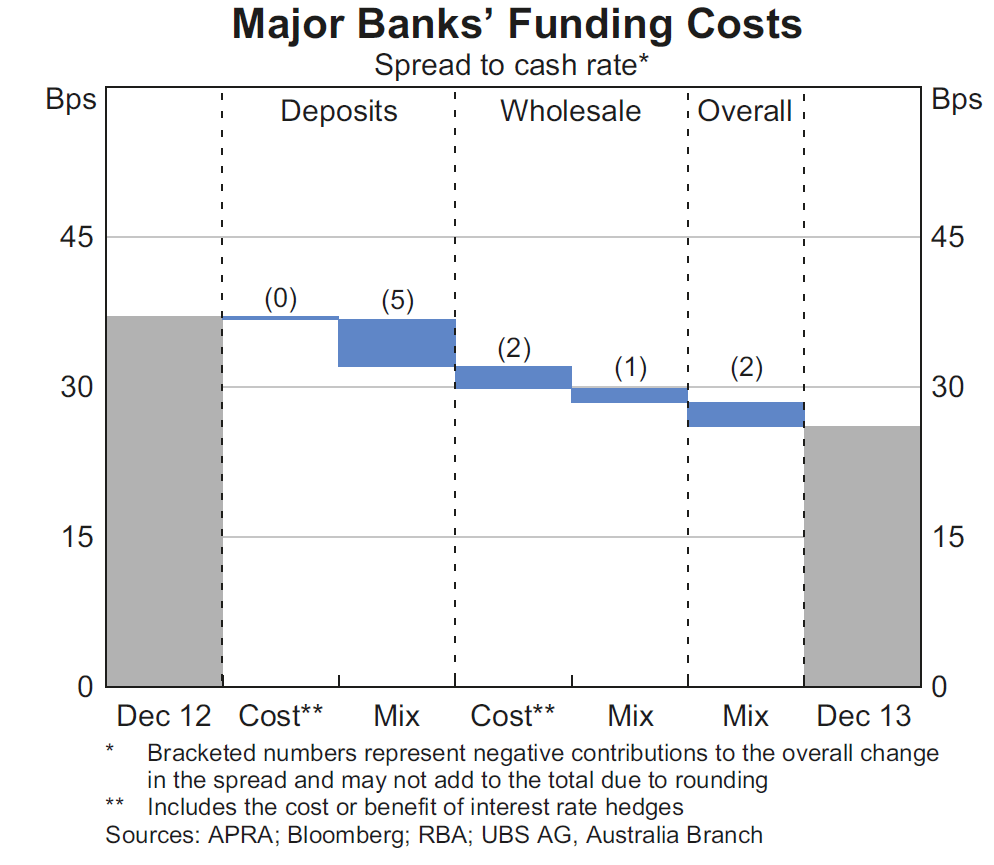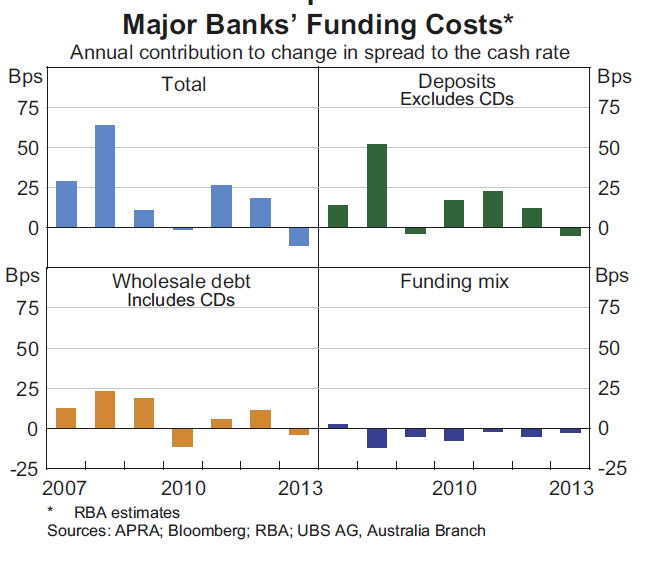Cross-posted from DFAblog.
The RBA published their quarterly bulletin today. It included information of bank margins and funding costs. “The main findings are that the absolute levels of banks’ funding costs and lending rates have fallen over the past year, and spreads between these rates and the cash rate have narrowed marginally. They highlight a fall in deposit margins, thanks to growth in on call savings by 4 basis points, and a fall in the home lending variable rate of 13 basis points, thanks to greater discounting as we highlighted earlier. Business lending margins are largely unchanged.
The authors, Leon Berkelmans and Andrew Duongmonths from the Bank’s Domestic Markets Department, go though the various drivers which flow into retail bank margins, and revise the methodology they use to measure them. I have extracted relevant charts and text to build the story.
“The absolute level of banks’ funding costs is estimated to have fallen by slightly more than the reduction in the cash rate over 2013. The cost of deposits fell, while the cost of outstanding wholesale debt also declined, particularly in the latter part of the year. In addition, there has been a shift in funding toward slightly cheaper sources. Relative to the cash rate, the major banks’ funding costs are estimated to have declined by about 11 basis points over the year.”

“Since mid 2012, the level of funding from term deposits has been largely unchanged, while transaction and at-call savings deposits have continued to grow. Because the cost of outstanding term deposits relative to the cash rate is higher than most at-call savings deposits and all transaction deposits, this shift in the mix has lowered the cost of deposit funding. Banks have decreased their use of term deposits as the relative cost of new term funding from the wholesale market has become more attractive. Moreover, some depositors may have been reluctant to lock in fixed interest rates at low levels, particularly if their expectations of future interest rates differed from market expectations.
Nonetheless, term deposits are still an important source of deposit funding, representing about 40 per cent of banks’ total deposit liabilities.
Changes in the overall cost of wholesale funding are estimated to have contributed about 4 basis points to the fall in the major banks’ cost of funding relative to the cash rate. Over the past year, the fall in overall funding costs reversed a trend of increases since the onset of the global financial crisis. Nonetheless, the major banks’ funding costs are estimated to remain close to 130 basis points higher than prior to that event”.

“In setting lending rates, banks take account of the cost of funding liabilities, the required return on equity, as well as the risk margin designed to cover potential losses from making a loan. Since the onset of the global financial crisis, increases in the cost of some of these factors – predominantly an increase in banks’ funding costs – have contributed to a widening of the spread between lending rates and the cash rate. Nonetheless, movements in the banks’ net interest margin since 2007 have been minor when compared with the broad compression they experienced over the two decades prior to that.
During 2013, the average interest rate on outstanding variable-rate housing loans drifted lower relative to the cash rate. The average interest rate on new variable-rate housing loans fell by about 10 basis points relative to the cash rate as discounts were increased. Moreover, the average interest rate on some new fixed-rate housing loans relative to expectations of the cash rate also fell over 2013. This was consistent with the small reduction in banks’ overall funding costs relative to the cash rate over the period, suggesting that risk and profit margins remained largely unchanged.
The interest rates on around two-thirds of business loans are typically set relative to the bank bill swap rate rather than the cash rate. Nonetheless, relative to the cash rate, spreads on both small and large business lending rates have fluctuated within a tight range over the past year. Business lending spreads today continue to reflect the reassessment of funding and lending risks since the crisis.”

